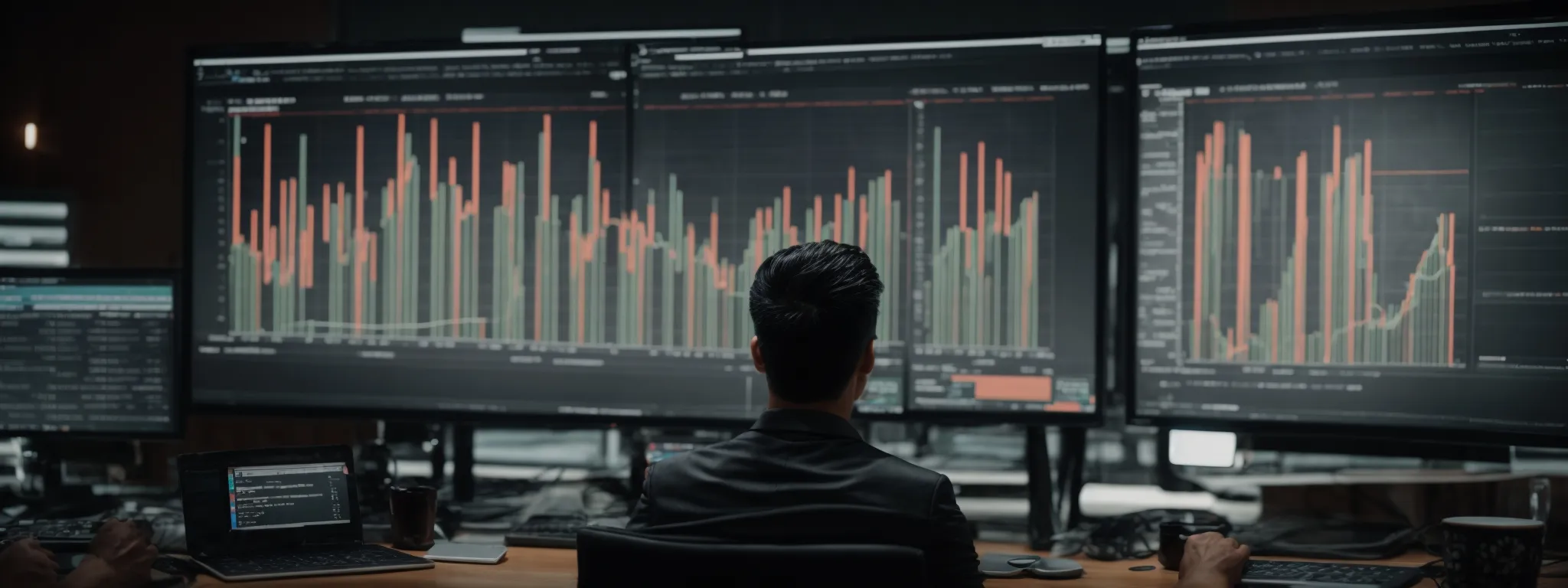Mastering SEO: Using Aggregate Google Analytics SEJ Tools
Mastering SEO: Leveraging Aggregate Data With Google Analytics SEJ Tools Navigating the complex waters of search engine optimization requires a compass, and for many, Google Analytics coupled […]
Mastering SEO: Leveraging Aggregate Data With Google Analytics SEJ Tools
Navigating the complex waters of search engine optimization requires a compass, and for many, Google Analytics coupled with SEJ tools represents just that.
By unveiling the capabilities of these tools, marketers can not only track but also amplify their SEO strategies through detailed, actionable data.
As businesses evolve in the digital age, understanding the subtleties of aggregate data becomes indispensable for outpacing competitors and achieving online visibility.
Keep reading to discover how to harness the full potential of SEJ tools within Google Analytics to refine your SEO endeavors.
Key Takeaways
- SEJ Tools Used With Google Analytics Provide SEO Professionals With in-Depth Data Interpretation for Strategic Planning
- Google Analytics and SEJ Tools Allow Businesses to Track and Refine Audience Targeting Using Demographic and Interest Data
- Analyzing Competitor Benchmarks Through SEJ Tools Enables Strategic Improvements for Better SEO Outcomes
- Custom Aggregate Reports in Google Analytics Facilitate Continuous SEO Improvement Through Tailored Performance Tracking
- Periodic Reporting Ensures the Adaptation and Evolution of SEO Strategies in Response to Analytics Data Over Time
Unveiling the Power of Google Analytics SEJ Tools

In the rapidly evolving realm of search engine optimization, having a reliable set of tools to parse through the labyrinth of data is indispensable.
Amidst this landscape, Google Analytics stands as a beacon of comprehensive data collection, while SEJ tools emerge as a conduit through which experts can harness this information, transforming it into actionable insights.
For SEO professionals who aim to craft bespoke strategies with precision, understanding the synergy between SEJ tools and Google Analytics becomes paramount.
The following discourse explores this integration, casting light upon the indispensable features that equip SEO professionals with the means to dissect aggregate data, enriching their understanding and mastery of the digital marketing domain.
Understanding the Basics of SEJ Tools
SEJ (Search Engine Journal) tools are designed to offer sophisticated functionalities that enhance the prowess of Google Analytics. These tools provide a layer of clarity over the raw data, rendering it more accessible and interpretable for SEO strategies.
The basic suite of SEJ tools integrates seamlessly with Google Analytics, which enables marketing professionals to execute a more granular analysis of web traffic behaviors and patterns:
- SEJ tools aid in identifying trends that inform content development and optimization efforts.
- They serve as a bridge, translating complex data into comprehensible reports for strategic planning.
- The usage of these tools enhances decision-making by providing insights backed by concrete data points.
Their capacity to interface effectively with Google Analytics ensures that users are not just overwhelmed with volumes of data but are equipped to extract meaningful narratives from the metrics.
How SEJ Tools Integrate With Google Analytics
SEJ tools are engineered to assimilate with Google Analytics, imbuing the latter’s robust analytics framework with enhanced interpretability. This integration authorizes the distillation of user behavior and acquisition channels into clear, strategic insights, freeing specialists from the tangled web of analytics interpretation.
In this melding of technologies, SEJ tools act as a magnifying glass to Google Analytics’ rich repository of user data. They refine the data collection process, allowing for pinpoint precision when assessing the stirrings of a website’s audience and optimizing for a more targeted UX.
Key Features of SEJ Tools for SEO Professionals
For SEO professionals, SEJ tools ingrain a level of specificity in the data aggregation capabilities of Google Analytics, ensuring that the actionable insights derived are both precise and tailored to the unique SEO challenges a website may face. With an emphasis on practicality, these tools distill complex data into actionable tasks and strategies, empowering users to execute with confidence and precision.
The array of features these tools provide represents a significant advancement in the realm of search engine optimization. By integrating seamlessly with Google Analytics, SEJ tools elevate a user’s ability to make informed decisions regarding their SEO campaigns:
- SEJ tools streamline the workflow of SEO experts, enabling them to identify and focus on metrics that have the greatest impact on search performance.
- They unlock the potential to visualize data in a user-friendly manner, enhancing comprehension and facilitating a proactive approach to SEO planning.
- With advanced functionalities, these tools cater to both granular and broad-spectrum examination of Google Analytics data, fitting the needs of diverse SEO objectives.
Moreover, these tools allow for an enriched correlation between various data streams, highlighting relationships that might not be readily apparent, thereby optimizing both on-page and off-page SEO elements. The precision afforded by SEJ tools means SEO professionals can sharpen their strategies, reinforcing the cornerstones of effective SEO: relevance, authority, and user engagement.
Setting Up SEJ Tools With Google Analytics

Embarking on the journey to master search engine optimization necessitates a solid foundation in interpreting and reacting to the wealth of data collected by analytics tools.
SEJ (Search Engine Journal) tools, in conjunction with Google Analytics, constitute a formidable combination for SEO experts who seek to distill volumes of aggregate data into potent strategic insights.
This section leads the professional through a meticulous guide to seamlessly integrate SEJ tools with Google Analytics.
From the initial setup and configuration to the crucial verification steps, readers are provided with the know-how to ensure their tools work in concert, delivering the valuable, data-driven groundwork required for advanced SEO execution.
Step-by-Step Guide to Connect SEJ Tools
Commencing the integration of SEJ tools with Google Analytics begins with obtaining the necessary access credentials. Professionals are advised to acquire an analytics API key from the SEJ suite, ensuring they have the required permissions to initiate the sync process.
Following acquisition, the link between Google Analytics and SEJ tools is established through the tools’ interface. Users will navigate to the configuration settings, entering their Google Analytics API details, thereby enabling a flow of data that is both secure and tailored for advanced SEO analysis.
Configuring Google Analytics for Aggregate Data
Configuring Google Analytics to effectively analyze aggregate data requires a meticulous approach to settings and parameters. SEO experts must fine-tune the system to capture relevant data that aligns with their strategic objectives, ensuring that every nuance of user interaction is accounted for and thoroughly analyzed.
Once the preliminary setup is complete, professionals can manipulate Google Analytics to focus on key performance indicators that reflect the collective behaviors and patterns of users. This configurational refinement allows for a comprehensive understanding of the target audience, which is instrumental in shaping successful SEO campaigns.
Verifying Proper Integration of SEJ Tools
Ensuring the proper functionality of SEJ tools in tandem with Google Analytics is a critical step for SEO practitioners. Upon alignment of these applications, one must execute a series of evaluative measures to confirm that the exchange of data is not only occurring without impediments but also reflecting the intended parameters set by the analyst.
Validation of integration can be accomplished by reviewing the coherence of reported data across both platforms. If metrics in Google Analytics resonate with the insights portrayed by SEJ tools, this serves as an affirmation that the tools are communicating effectively and can be relied upon for comprehensive SEO strategy development.
Deciphering Aggregate Data for SEO Insights

Aggregate data embodies the essence of SEO intelligence—the fundamental strands of information that, when woven together, offer a comprehensive view of a website’s performance within the intricacies of search engine parameters.
Tapping into the wealth of metrics available through Google Analytics, SEO cognoscenti scrutinize patterns and trends that indicate not only user behavior but also the site’s overall health and potential areas for refinement.
Yet, even the most seasoned professionals must remain vigilant against the common missteps that can skew interpretation, ensuring that the synthesis of this robust data provides precise and actionable insights, rather than misleading anomalies.
What Aggregate Data Means in Google Analytics
Within the Google Analytics ecosystem, aggregate data represents the sum of user interactions over a given timeframe, providing a broad overview of website performance. This holistic perspective aids SEO experts in pinpointing overall audience behavior, such as pageviews, session duration, and bounce rates, which are indispensable for crafting nuanced marketing strategies.
Understanding aggregate data in Google Analytics affords marketing professionals the capacity to identify overarching trends and areas for optimization. It is the distilled essence of user activity across a website, translating diverse user actions into a comprehensive dataset for in-depth analysis and strategic planning.
Interpreting Data Patterns and Trends
Interpreting data patterns and trends through Google Analytics SEJ tools opens a new dimension of SEO strategy. SEO specialists gain an x-ray vision into the performance metrics of their websites, distinguishing between short-lived anomalies and the enduring movements that dictate the direction of user engagement and content effectiveness.
The capability to differentiate signals among noise equips professionals with the foresight needed to preemptively adjust SEO tactics. It’s this analytical prowess that ensures the relevance and optimization of web content align with evolving search behaviors and preferences:
| Month | Pageviews | Unique Visits | Bounce Rate | Avg. Session Duration |
|---|---|---|---|---|
| January | 12,000 | 7,500 | 40% | 3:15 |
| February | 15,000 | 9,200 | 35% | 3:45 |
| March | 14,500 | 8,800 | 38% | 3:30 |
Common Pitfalls While Analyzing Aggregate Data
Analyzing aggregate data through Google Analytics and SEJ tools offers insightful glimpses into user behavior and site performance, yet it is not without its challenges. One of the main pitfalls is confirmation bias, where analysts may unknowingly seek out data that supports their preconceived notions, consequently overlooking contradictory information that could be crucial for strategy development.
Misinterpretation of data can lead to misguided decisions that affect the trajectory of SEO efforts: for instance, mistaking correlation for causation or not accounting for seasonal traffic fluctuations. Analysts must approach data with a critical eye and a readiness to question assumptions to extract the most accurate insights.
- Confirmation bias can skew interpretation and lead to one-sided strategies.
- Recognizing the difference between correlation and causation eliminates the risk of inaccurate conclusions.
- Accounting for seasonal variations ensures strategies are effective throughout the year.
Tracking and Analyzing Organic Search Data

In the realms of digital marketing, organic search data stands as an undeniable cornerstone for a successful SEO campaign.
Harnessing the potential of this data requires meticulous tracking and extensive analysis.
SEO professionals, armed with Google Analytics and SEJ tools, can meticulously tailor their approach, setting up intricate tracking systems to capture organic traffic nuances and extract valuable insights.
By identifying pivotal key performance metrics and employing the advanced capabilities of SEJ tools, they are able to dissect the layers of organic search data, revealing opportunities and weaknesses in their strategies.
With this, they position themselves to refine and enhance their SEO activities, ensuring they resonate with the intended audience.
Setting Up Organic Search Data Tracking
Within the landscape of digital marketing, setting the stage for comprehensive organic search data tracking is pivotal. SEO professionals employ Google Analytics and SEJ tools to configure precise trackers that home in on organic search performance, laying the groundwork for insightful analysis.
Accurate tracking ensures that every click and query contributing to web traffic is accounted for, yielding a detailed map of organic search trends. This process empowers marketers with the capability to align their optimization strategies with the actual search behaviors of their target audience, enhancing effectiveness and reach.
Identifying Key Performance Metrics
Within the scope of search engine optimization, the discernment of key performance metrics acts as a beacon, guiding SEO professionals in navigating the vast ocean of organic search data. It is through this discernment that strategies emerge, informed and calibrated with the precision necessary to meet the evolving demands of search engine algorithms and user preferences.
The process begins with a meticulous selection of metrics that are most indicative of organic search success: these metrics serve as a litmus test for the efficacy of content and keywords, signaling where adjustments are warranted and validating the accomplishments of implemented tactics:
- Organic search impressions offer a glimpse into the visibility and reach of web pages.
- Click-through rates (CTR) reflect the allure and relevance of search results listings.
- Conversion rates from organic traffic underscore the end goal of turning visitors into customers or leads.
By steadfastly monitoring these key indicators, SEO experts are able to shape campaigns that not only attract traffic but also drive meaningful engagement and conversions. This focused approach underscores the value of tailored content and optimization, propelling websites toward the apex of search engine results pages.
Utilizing SEJ Tools for Advanced Organic Analysis
When it comes to advanced organic analysis, SEJ tools distinguish themselves by offering a suite of optimization features that complement the vast data architecture of Google Analytics. These encompass a selection of diagnostic and monitoring capabilities, allowing users to delve deeply into metrics specific to organic search performance.
Utilizing these instruments, marketers extend their capacity to interpret and act on data with greater precision:
- These tools assist in uncovering the subtleties of keyword effectiveness and their contribution to enhanced SERP positioning.
- They streamline the process of identifying opportunities for content enrichment, based on organic search insights.
- Marketers can deploy these resources for content adjustments in real-time, aligning with emerging SEO trends.
Enhancing Keyword Analysis With Aggregate Data

In the intricate world of search engine optimization, the confluence of aggregate data and keyword analysis stands as a linchpin for success.
Analyzing patterns within Google Analytics lends precision to keyword performance, revealing which terms drive traffic and engagement.
Through the adept utilization of Search Engine Journal (SEJ) tools, SEO professionals can push the boundaries of traditional analysis; not only identifying high-performing keywords but also unlocking nuances that inform strategy refinement.
Embracing this synergetic approach transforms aggregate data from a mere collection of numbers into a wellspring of actionable intelligence, propelling SEO strategies from reactive to proactive stances.
Linking Google Analytics With Keyword Performance
LinkGraph’s SearchAtlas stands at the forefront of redefining how SEO professionals connect keyword performance with aggregate data gleaned from Google Analytics. This sublime integration offers a transparent view into keywords driving organic traffic, enabling strategists to gauge the effectiveness of their optimization efforts with exactitude.
Through the advanced capabilities of SearchAtlas, marketers delve into the multifaceted relationship between user searches and site visibility. Such deep insights empower them to refine targeted keywords, optimize for greater relevance, and ensure content resonates with search intent, ultimately bolstering a website’s position on search engine results pages.
Advanced Keyword Analysis Using SEJ Tools
SearchAtlas by LinkGraph emerges as a pivotal instrument in the Advanced Keyword Analysis, empowering SEO professionals to harness the intricacies of aggregate data. The tool’s precise algorithms dissect search trends and user engagement, revealing keyword opportunities that might otherwise remain obscured in the vast seas of Google Analytics data.
With SearchAtlas, SEO experts can effectively pinpoint the keywords that are not only prevalent but also have the highest impact on their target audience. This allows them to streamline their content strategy and heighten their overall online presence in a manner that is both data-driven and user-focused.
Fine-Tuning Your SEO Strategy With Actionable Data
Refining an SEO strategy pivots on the utilization of actionable data distilled from aggregate figures, a task where tools like SearchAtlas excel. By interpreting the granular details hidden within Google Analytics, LinkGraph’s SearchAtlas equips SEO professionals with the nuanced insights necessary to calibrate their approach, ensuring content and keyword strategies are aligned with actual user behavior and search trends.
With the precise data analytics provided by SearchAtlas, marketers are empowered to adapt their SEO tactics in response to the ever-changing digital landscape. This dynamic approach not only improves visibility across search engines but also paves the way for an enhanced user experience, thus driving better engagement and fostering increased loyalty among the target audience.
Leveraging Audience Demographics and Interests

In the modern theater of search engine optimization, a clear comprehension of audience demographics and interests is pivotal.
Transitioning beyond basic keyword optimization, these facets offer a finer filter through which SEO professionals can view their audience, enhancing the fidelity of their targeting efforts.
Google Analytics provides a repository of audience demographic data, while SEJ tools elevate the practice by offering deeper insight into user interests.
Applying this wealth of data strategically allows for the refinement of targeting approaches, ensuring that marketing messages resonate with greater specificity and impact with the intended cohorts.
Analyzing Audience Demographics in Google Analytics
Analyzing audience demographics in Google Analytics empowers businesses to understand the composition of their website visitors by age, gender, interests, and geographical location. This understanding is critical, as it allows companies to tailor their SEO and marketing efforts to the segments of their audience that are most engaged or show the highest conversion potential.
Through Google Analytics, businesses gain access to a rich vein of demographic insights, which can be leveraged to enhance user experience and increase the relevance of content, ensuring it meets the specific needs and interests of different user groups. Strategically applying these insights is integral to optimizing online content, thus driving performance in search engine results and achieving targeted marketing outcomes.
Understanding Audience Interests With SEJ Tools
SEJ tools elevate the exploration of audience interests by providing nuanced layers of analysis atop Google Analytics data. These tools enable SEO practitioners to distill broad demographic information into specific interest categories, painting a sophisticated portrait of user preferences and engagement with content.
By employing SEJ tools, experts can decode the subtle patterns of user behavior, discerning the topics and themes that captivate their audience. This intelligence fosters informed decision-making within the realm of SEO, guiding content creation and optimization to meet the nuanced demands of an ever-evolving online ecosystem.
Applying Audience Data to Improve Targeting
Incorporating audience data into targeting strategies transforms generic outreach into a Precision-Driven Endeavor. By observing and categorizing the demographics and behaviors of website visitors, savvy marketers create tailored experiences that resonate more deeply with each segment.
With the actionable insights gathered from Google Analytics and enriched by SEJ tools, businesses Refine Their Marketing Messages and make informed decisions about where to allocate their resources for maximum impact:
| Demographic | Interest Category | Session Duration | Conversion Rate |
|---|---|---|---|
| 25-34 Year Olds | Technology Enthusiasts | 5:20 | 3.2% |
| 35-44 Year Olds | Fitness Aficionados | 4:45 | 2.9% |
This hyper-focused approach to targeting, fed by a rich stream of data, enables campaigns to achieve greater relevance and conversion, satisfying the dual objective of optimizing both user experience and marketing return on investment.
Competitor Benchmarking With SEJ Tools

In the cutthroat arena of digital marketing, keeping a pulse on competitors is as crucial as understanding one’s own data.
With the advanced functionalities of Google Analytics SEJ tools, SEO professionals gain the upper hand by conducting meticulous competitor benchmarking.
These tools facilitate not just the identification of industry rivals but also enable in-depth analysis of their aggregate data.
By tapping into this competitive intelligence, businesses can unearth strategic insights, setting a stage for informed decision-making.
Benchmarking serves as a navigation tool to chart out paths less traveled, offering fresh perspectives to outpace competitors in the ever-changing marathon for online prominence.
Identifying Your Competitors in SEJ Tools
Exploring the capabilities of SEJ tools equips SEO practitioners with the ability to pinpoint and analyze their market competitors. By leveraging the rich feature set within these tools, users gain a strategic advantage, identifying those who vie for the same digital space and potentially share their audience segments.
Deploying SEJ tools not only simplifies competitor discovery but also provides a cohesive snapshot of their online tactics. This functionality facilitates a clearer understanding for SEO professionals, allowing them to adjust their strategies adeptly in the context of the competitive landscape.
Analyzing Competitor’s Aggregate Data
Strategic Deployment of SEJ Tools enables SEO experts to perform a detailed analysis of their competitors’ aggregate data. By accessing this key information, they can assess ranking factors, backlink profiles, and content performance metrics, shedding light on the strategies fueling their rivals’ SEO success.
Insights gleaned from competitive aggregate data analysis pave the way for strategic adaptations in one’s SEO playbook. Armed with the intelligence that SEJ tools provide, businesses can benchmark their performance against the competition, identify gaps in their approach, and unveil opportunities for growth and authority in their respective niches.
Gaining Insights From Competitor Benchmarks
Competitor benchmarks through SEJ tools illuminate pathways to strategic enhancement. These insights allow SEO professionals to comprehend the strengths and weaknesses of their rivals, guiding their own optimization efforts.
Furthermore, interpreting benchmark data facilitates the identification of industry best practices and emerging trends: savvy marketers can then adapt and innovate, ensuring their SEO tactics are not only current but also ahead of the curve:
| Competitor | Domain Authority | Backlink Profile | Organic Traffic |
|---|---|---|---|
| Competitor A | 65 | 4,200 | 120,000 |
| Competitor B | 58 | 3,100 | 95,000 |
| Your Site | 62 | 3,800 | 110,000 |
Armed with Comparative Performance Metrics, businesses fine-tune their SEO strategies to capitalize on identified opportunities. As a result, they not only keep pace with but potentially surpass their market peers in capturing the attention and loyalty of their shared target audience.
Measuring SEO Success With Aggregate Reports

Within the realm of search engine optimization, success is often gauged by the ability to translate vast quantities of data into meaningful insights.
Utilizing custom aggregate reports in Google Analytics supplemented by SEJ tools, SEO professionals can assess their triumphs with precision, tracking crucial metrics that signify growth and engagement.
These tailored reports enable a comprehensive view of conversion and engagement metrics, fostering a culture of continuous improvement through periodic, data-driven reporting.
By maximizing the potential of these reports, businesses can refine their SEO strategies, ensuring adaptation and evolution in a competitive digital environment.
Custom Aggregate Reports for Tracking Success
Custom aggregate reports stand as a critical component for SEO professionals seeking to scrutinize the efficacy of their strategies within the Google Analytics framework. These reports allow for a nuanced representation of performance, aligning data visualization with key strategic goals.
Upon implementing these tailored reports, businesses unravel the tapestry of interaction between their digital spaces and the target audience. The insights extracted dictate the trajectory for ongoing optimization, rendering a dynamic SEO strategy that responds to real-time analytics:
| Campaign | Keyword Group | Impressions | Clicks | Conversions |
|---|---|---|---|---|
| Spring Sale | Discount Deals | 35,000 | 3,000 | 300 |
| Product Launch | New Tech Gadgets | 50,000 | 5,500 | 550 |
Thus, the integration of custom aggregate reports within Google Analytics produces a robust mechanism for measuring SEO success, transforming reams of raw data into strategic waypoints and benchmarks for continual improvement.
Interpreting Conversion and Engagement Metrics
Analyzing Conversion and Engagement Metrics through Google Analytics with SEJ tools provides SEO professionals with insight into the effectiveness of their digital strategies: it reveals not just the volume of traffic but how that traffic interacts with their online presence. The ability to quantify user actions, from initial click to final conversion, offers a practical measure of how well a website captivates and carries its visitors through desired pathways and actions. These metrics are the lifeblood of gauging campaign performance and directing future optimizations.
| Campaign | Keyword Group | Impressions | Clicks | Conversions |
|---|---|---|---|---|
| Summer Clearance | Seasonal Discounts | 28,000 | 2,800 | 280 |
| New Product Highlight | Innovative Designs | 45,000 | 4,500 | 450 |
Essential to an SEO expert’s arsenal, interpreting these conversion and engagement metrics serves as a compass, pointing to the strengths and weaknesses of current strategies. By assessing user engagement depth and the conversion ratios, professionals unveil the ROI of SEO initiatives. This analysis yields actionable data, guiding tweaks and refinements that ensure the brand message resonates, users are satisfied, and business goals are met.
Continuous Improvement With Periodic Reporting
Periodic Reporting is the heartbeat of continuous improvement in SEO. By routinely tracking performance through the lens of aggregate data, businesses witness the evolution of their SEO strategies, distilling the essence of success into a series of snapshots over time.
With regular intervals of comprehensive analysis, SEO practitioners adjust their methods to keep pace with the dynamic landscape of search engines and user behavior. This iterative process forms the foundation of a sustained upward trajectory in SEO efficacy and web presence:
| Quarter | Target Keywords | Organic Impressions | Website Sessions | Conversion Rate |
|---|---|---|---|---|
| Q1 | Health Supplements | 100,000 | 15,000 | 2.5% |
| Q2 | Fitness Gear | 120,000 | 18,000 | 3.0% |
| Q3 | Nutrition Tips | 135,000 | 20,000 | 3.5% |
Conclusion
Mastering the intricacies of SEO through aggregate data with Google Analytics and SEJ tools is essential for developing successful optimization strategies.
By analyzing demographic insights and understanding user interests, SEO professionals can tailor their content to match audience needs, leading to increased engagement and higher conversion rates.
SEJ tools, when integrated with Google Analytics, empower marketers to delve into organic search data, track key metrics, and refine keyword optimization with precision.
Regularly creating custom aggregate reports allows for tracking SEO success and guiding continuous improvement.
Competitor benchmarking with these tools also offers invaluable insights for outpacing industry rivals.
Overall, the ability to leverage aggregate data through these sophisticated tools enhances decision-making and strategy development, ensuring a competitive edge in a dynamic digital landscape.















































































